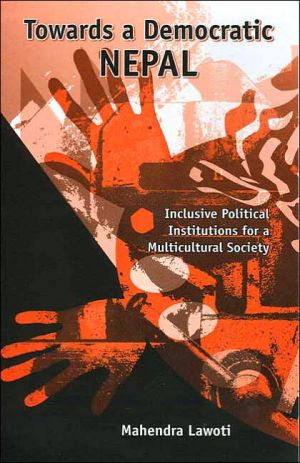

 |

|

The average rating for Towards a Democratic Nepal: Inclusive Political Institutions for a Multicultural Society based on 2 reviews is 3 stars.
Review # 1 was written on 2008-03-27 00:00:00 John pearmon Pearmon John pearmon PearmonOne of the most amazing books I've ever read. Sinha addresses the effects of colonial discourse on a global scale, while argung that Indian women used debates over their sexuality to argue for individual rights. I reference it at least three times a week in various converstaions. |
Review # 2 was written on 2016-11-23 00:00:00 Donald Jacobson Donald JacobsonIn 1927, Katherine Mayo published Mother India, a book-length piece of character assassination against Indian self-government. The controversy over Mayo's book occurred within and shaped a changing balance of forces. After the First World War, the increased prominence of the United States in world affairs contributed to making Britain particularly sensitive to American opinion. Nationalists in India also had a wave of changes in the government of the empire's other holdings to look to, such as the British response to the Easter Rising in Ireland. Within India, a variety of movements arose or intensified during the late 1920s. Ties beyond India's border - and ultimately the British Empire's as well - made Indian movements players on a global field. Mayo made claims about the treatment and status of women central to her charge that India was not ready for self-government. Mayo's claims unwittingly ended up supporting calls for Indian self-determination, however, in that the India Mayo excoriated was under British government. Indian nationalists argued that conditions in India were not an indictment of Indians but of the colonial government. The answer to the problems Mayo noted was not continuing but rather ending British rule Nationalist reframing of Mayo's claims is not Sinha's sole concern. Sinha criticizes Indian nationalists as well as - though not as much as - the British. Specters underscores that the Mayo controversy involved new possibilities for Indian women, some of which were not fulfilled by the success of nationalist movements. Prior to the Mayo controversy India was largely organized politically around communities. Colonial authorities had essentially made a deal with conservative religious and traditional authorities to leave women's issues in these authorities' hands, in exchange for some level of loyalty. Nationalist movements largely shared the impulse to keep women from political agency. During the Mayo controversy women's political activity surged. A major outcome in the aftermath of Mother India was the Child Marriage Restraint Act of 1929. Women were instrumental in the creation and passage of this act. The particular manner in which women participated in this change matters: women appealed not to communities but to individual rights, thus creating a cross-community constituency of women. Attention to the Mayo controversy shows that the path followed by Indian national liberation movements was a contingent and ambivalent affair. While in the end nationalists close some of the space women opened for themselves, this closure was not foreordained. Here Sinha builds on and contributes to the work of Dipesh Chakrabarty, Partha Chatterjee, and others from the Subaltern Studies circle. She take a stance critical of colonialism while both historicizing Indian nationalism and challenging nationalist history and memory. Sinha stresses that the alternatives present in the Mayo controversy offer potential political lessons in the present. While this portion of the book is not always completely clear, dealing with questions like the foundations of political rights and alternative conceptions thereof, it is refreshing to read a historical work unashamedly expressing political concerns in the present. The point that "historical method pries open a range of political possibilities from the historical sedimentation resulting from dominant cultural practices" is an important argument for the continuing relevance of history beyond scholarship for its own sake. (251.) The primary shortcoming in Specters is the treatment of class. Sinha admits to the class biases and background of the Indian women's movement, and notes the occasional instances when the movement did address lower class issues such as women's wages. Still, Sinha does not integrate class fully into her perspective. She treats women as a political constituency forged across real divisions. This is a reasonable, perhaps even laudable perspective. But Sinha implies that women qua women had certain interests in common in such a way that does not treat their differences as central to their interests as women. This subtly undermines important point that constituencies - and by implication interests - are not so much found as made. This also bears on the present political lessons Sinha believes can be drawn from the Mayo affair. The implicit lessons of Specters privilege gender identity over class position, or at the very least separate the two. Nonetheless, Sinha's book remains an impressive piece of scholarship which can speak to multiple bodies of work. Literary scholars might profit from her reading and contextualization of Mayo's book. Political historians can take her work as an exemplar of how to link social policy with a broader cultural and social context. All historians interested in moving beyond nation-centered history can learn from the way Sinha treats an event spanning the United States, Britain, and India. |
CAN'T FIND WHAT YOU'RE LOOKING FOR? CLICK HERE!!!